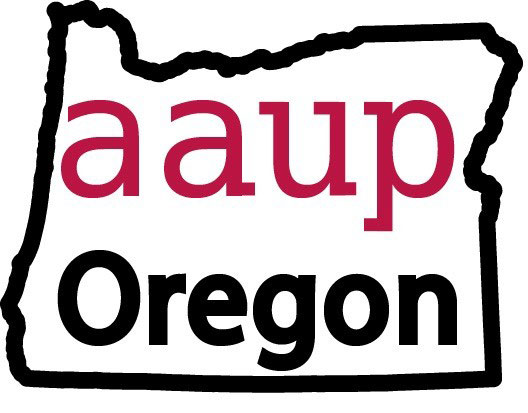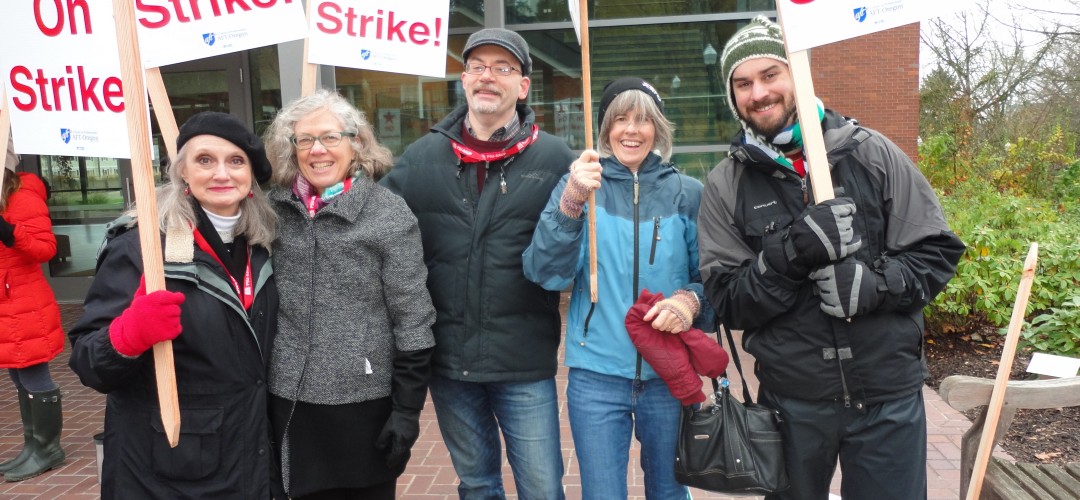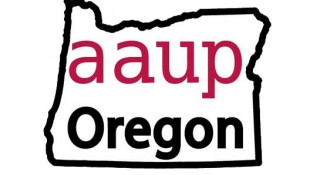
What’s Going On at AAUP-Oregon – by Margaret Butler, Executive Director
Building the Movement – by Jóse Padin, President
In the News
Chapter Updates
– PSU
– UofO
– OSU
– Marylhurst
Save the Date!
What’s Going On!
by Margaret Butler, Executive Director
Welcome to the first newsletter of AAUP-Oregon. You are receiving this newsletter because you are a member of AAUP-Oregon—either through your AAUP chapter, or as an individual.
 Leaders from PSU-AAUP, United Academics at the University of Oregon, and the AAUP advocacy chapter at Oregon State came together in 2012 and 2013 to rebuild an AAUP state conference in Oregon.
Leaders from PSU-AAUP, United Academics at the University of Oregon, and the AAUP advocacy chapter at Oregon State came together in 2012 and 2013 to rebuild an AAUP state conference in Oregon.
The leaders proposed a statewide organization which would bring faculty in Oregon together to build power and advocate for faculty and for quality higher education in our state. Over the last eleven months, we have taken a number of steps to start building the organization and creating structures to build a strong faculty voice in Oregon. First as Executive Coordinator and now as Executive Director, it has been my honor to support those steps and our growing program areas.
In April we convened our statewide annual conference in Corvallis, which drew about 60 faculty members to hear stories of faculty organization at PSU, OSU and UO, and to discuss our priorities moving forward. From that meeting some key proposals surfaced: that we would coordinate collective bargaining in the public universities as much as possible; that we would create a legislative program where we can speak with one voice; that we would move ahead with an organizing program, and that we would break down barriers to statewide solidarity. There was clearly a hunger for faculty from different educational institutions to be in ongoing relationship with each other, to learn from each other’s experiences, and to have each other’s backs.
In May and June, AAUP-Oregon President José Padín and I met with leaders from the three big campuses; all were excited about taking the next steps. We also met with David Rives, President of AFT-Oregon, and discussed the possibility of holding a Collective Bargaining summit; David was delighted and offered to help invite AFT participation from their locals at Eastern Oregon and Western Oregon, as well as AFT-represented grad students. Mary King, the VP for Collective Bargaining had already been convening calls of bargaining leaders throughout the old Oregon University System. Mary and José led the planning for the Collective Bargaining Summit.
AAUP-Oregon convened our first ever statewide Collective Bargaining Summit in Eugene on Sept 24th. Faculty from six Oregon public universities plus staff from AAUP and AFT worked together to envision a common set of long term goals, look at our strategies for engaging with the new independent boards, and plan for next steps.
Since the CB summit, AAUP-Oregon and AFT-Oregon leaders have met to look at how to partner as we do this work, which includes bargaining strategies, legislative strategies, organizing and communication.
On October 25th, AAUP-Oregon convened a legislative summit to hear about legislative programs and priorities from our allies, hear about a successful legislative program in Ohio, and start to envision our own legislative program. The AAUP-Oregon Executive Committee will follow up with details about how our legislative program will work at our January Executive Committee meeting.
We have also moved ahead on our organizing program. In July, AAUP-Oregon hired Kevin Dugan as an organizer. We were able to afford Kevin with support by national AAUP, and he is spending part of his time on a couple of exciting new campaigns we hope to report in our next issues. Kevin is also helping build AAUP advocacy chapters in Oregon and is available to assist with internal organizing for affiliated chapters of AAUP-Oregon.
2015 will be a big year for the growth and effectiveness of our statewide body. Stay tuned for lots of action!
Building the Movement
by José Padin, President
Oregon needs a movement for public higher education. A pro-democracy movement. A class-justice movement. A student-and-families debt-freedom movement. A we-value-human-beings-over-marketing-and-technology-gimmicks movement for higher education.
Oregon’s grassroots citizens’ movement is needed to answer one of the burning questions of our time: Are life, liberty, and the pursuit of happiness better served by a guaranteed, universal right to higher education, or by a revenue-first information-delivery industry where the learner is turned into a buyer of consumer services, and institutions of higher learning are turned into marketplaces hawking credentials?
Oregon has plenty of spirit and fight to answer this question!
Consider some high points in the last two years:
Faculty at the University of Oregon organized for a democratic vision of higher learning, and to that end, they formed a faculty union, United Academics-UO. These faculty at the UO were the leaders in the creation of a new way of doing things at the University of Oregon: active participation from representatives of the faculty in figuring out the direction and standards for the UO, jointly with their administrators, plus a commitment to giving this joint work the status of an enforceable covenant.
At Portland State University, full-time faculty and academic professionals, working through their organizations, the PSU chapter of the American Association of University Professors, and the Faculty Senate, stood up in 2014, nearly going out on strike, to say “no more, not on our watch” to a PSU administration that had quietly allowed (consciously, or not) a shift of scarce resources out of the classroom and into exceedingly high salaries for a growing caste of top administrators, and into expenditures with little bearing on education. PSU faculty and academic professionals did this in coalition with students, part time faculty, classified university workers, and with support from citizens and public officials and community leaders across the state.
The Oregon Student Association (I just learned) registered an impressive 50,000 students to vote last year. OSA plays a leading role in a statewide coalition to change the more-student debt-for-less-education model.
As I write, the Graduate Teaching Fellows at the University of Oregon, 1500 graduate student employees who do a third of undergraduate teaching and most of the grading, are striking to get the UO administration to see a very elementary fact: family and emergency leave and living wages for teachers are indispensable for a good teaching and learning environment.
Human needs-centered education and intellectual freedom are our values and vision. There is no getting there but by well-funded universities, university administrations that don’t misuse our scarce resources, and a priority placed on top working conditions for faculty and everyone else that makes the university work; these working conditions are the learning conditions of our students.
Cuts in funding for colleges and universities; shrinking rosters of full-time university professors; huge growth in part-time professors working on insecure terms and sometimes near-poverty conditions; an unregulated explosion of the online “information delivery” sector with no pause to examine the conditions for quality education–these are the current direction of higher education. This is the wrong direction for our society.
The Oregon Conference of the American Association of University Professors was reborn in 2013, on the eve of 100th birthday of the American Association of University Professors, 1914-2014, the pioneer defender of academic quality and freedom in the United States. We are an organization by our members (thousands, many with decades of teaching, research, and service to the community), we stand for education in the service of human excellence and democracy, and we enthusiastically join Oregon’s movement for a universal citizen right to higher education. Oregon, count us in!

Marylhurst Chapter story in national AAUP’s Academe
United Academics at UO story in national AAUP’s Academe
PSU
 PSU report by Pam Miller,
PSU report by Pam Miller,
President, PSU-AAUP:
Greetings from PSU-AAUP and I hope this message finds you all well.
At our meeting in Eugene on September 24, we discussed our Board of Trustees (BOT) at PSU, U of O, and OSU. We began narratives about our unique relationships with these new entities, and we shared some strategies for how our unions might interact with and have influence on their processes. One strategy that I shared was the request for a standing spot of five minutes on the Board’s agenda at each meeting to provide an update on PSU-AAUP business. I asked the Board of Trustees at their meeting on September 11 to consider this request and was told by the Chair of the Board that he would get back to me. PSU-AAUP’s interactions with the BOT have unfolded (unraveled might be a better term) a bit more since we last met, and I would like to give a brief update on what has happened.
Here is some important context that highlights the Board of Trustees interactions with all stakeholders and with the four unions on the PSU campus. The Board officially started on July 1 of this year and the first major order of business is to decide if PSU should have an armed police force. There has been a task force in place that has brought forward several recommendations, including the need for officers to carry guns, to the President who turned the final decision over to the BOT. A committee of the Board, the Special Committee on Campus Public Safety, was formed to explore this and they have met twice, once in October and once in November. They are to bring a resolution to the full Board for a vote at their December 11 meeting. In October, PSU-AAUP did a survey of the membership about guns on the campus and the response rate was 42%, with 68% against guns and 32% for an armed police force.
Invited by this Committee to speak at the October meeting, I presented our data. It became increasingly apparent that access to the Board members would only be during meetings or via a website. There is no contact information for them on the Board’s webpage. Here is a quote from my presentation, “We need to be able to engage with the Board through e-mails and letters and by appointments to allow for our divergent opinions, questions, concerns, and expertise to be heard and considered…this feels like a corporate model of doing business with decision makers far removed from those who live here, work here, and attend classes here…WE ARE PSU!”
Two days later, I received a phone call from the Chair of the Board informing me that PSU-AAUP would not be allowed a standing agenda time. I was assured that this decision was made before my words “corporate model” were spoken two days previous. I was “welcome” to sign up for the public comment time or ask for time on the agenda and my request would be considered. It was explained to me that the Board already has the Faculty Senate Presiding Officer and the ASPSU (Associated Students of PSU) on the agenda and that is enough for now…the Board is very busy.
Fast forward to November 24, the second meeting of the Special Committee on Campus Public Safety. My words of a corporate model paled in comparison to feedback and some direct confrontation that took place at this meeting. Except for the 90 minute filibuster from administrators, and the letter from the President of PSU (who is very clear that he wants an armed police force and could not be at the meeting), and one person in the public comment time, every speaker was against guns. The Committee seemed a bit overwhelmed, did not decide on a resolution about an armed police force on the PSU campus. They will meet again very soon to figure out next steps so they have that resolution that the President has asked for to take to the full Board on December 11. However, two members said very clearly that “no more public comment was needed.” Really? That shuts out just about everyone, except the administrators who have talked about the need for guns for hours and hours and yet those in the public comment time get 2 minutes each.
So, enough for now and I can’t tell you just yet how the story ends so stay tuned! What is becoming clear is that this Board of Trustees is not interested in listening to the unions and it appears that the Board may rubber stamp what the President wants (armed officers) despite mountains of feedback and data from faculty, staff, and students. I believe that telling PSU-AAUP to sign up in the public comment time (that could be removed at the Board’s discretion) is insulting and does not bode well for future interactions, especially when bargaining season gets underway.
Stay tuned…WE ARE PSU!
University of Oregon

by Deborah Olson,
VP for Communications and Public Relations, AAUP-Oregon
United Academics has had a hectic fall term. In September the Executive Council developed plans for our Representative Assembly and General Membership meetings, a membership drive, and steward recruitment. The meetings have gone generally as planned: the Representative Council approved the bargaining platform that had been developed over the summer by the Collective Bargaining Committee and the GMM was very well attended. Food, drinks and door prizes made for a very festive event at the latter.
What we didn’t plan for, of course, was a breakdown in negotiations between the Graduate Teaching Fellow Federation (GTFF) and the University of Oregon administration. The strike began on the morning of December 2. The crux of the matter is paid leave for the 1500 graduate teaching fellows. The administration is preparing to break the strike by hiring “ad hoc” workers and by suggesting that faculty give multiple-choice final exams, cancel exams altogether, or require no papers be assigned in the final weeks of the term, regardless of what appeared in one’s syllabus. It was also announced that department heads would be placed as instructors on certain Blackboard sites, presumably of large lecture classes with discussion groups run by GTFs.
Needless to say, UA has been communicating with its bargaining unit members alternatives to the administration’s draconian measures. The UO Senate has condemned the plans with the passage of a motion drafted by Senate members who are also UA members. UA leadership, under the direction of President Michael Dreiling, worked tirelessly to urge both sides to come to an agreement. The crisis has necessitated UA to more finely tune our communication strategies, which will serve us well in the future. As of this writing, UA members are joining the students on the picket lines, when possible. We cannot join their strike by the terms of our own collective bargaining agreement, but we have attended their rallies and recognizing the hard work of walking a picket line in cold, wet weather we are being supportive by providing pizza and hot chocolate. You can send a message to Interim President Scott Coltrane asking him to settle the strike by clicking here.
Meanwhile, UA continues to meet with UO Academic Affairs representatives in a joint implementation committee to continue the roll out of our Collective Bargaining Agreement. UO faculty, including UA activists, are engaged in finalizing internal governance documents and writing work load and promotion and review policies for non-tenure track faculty. We have identified the bargaining team for negotiating our 2nd contract; negotiations that will begin in January.
OSU
OSU report by Tony Vogt,
OSU AAUP Advocacy chapter:
This year, the OSU Chapter of the AAUP sponsored a survey of Non-Tenure-Track faculty members, collecting answers from over 1200 instructors, research assistants and professional faculty. Results were presented to the Faculty Senate in March, and to the campus community in a series of public events in April and May, generating local press coverage and robust conversations, in particular around contract length, job security, fair compensation and promotion. Recommendations were made to Faculty Senate in June; we’re still awaiting action. A similar survey conducted a decade ago, followed by similar recommendations, resulted in little to no changes, so we are planning to closely monitor and follow up on institutional/ administrative responses to the survey. We intend to keep these issues public, and not allow recommendations to “die in committee.”
We also hosted two inspiring and productive AAUP statewide conferences on the Corvallis campus this past year, with representatives from all higher education institutions in the state.
Our chapter meets regularly to work on a number of issues affecting students and faculty, and we maintain a supportive alliance with other unions on campus. We seek to actively grow as a chapter, and increase our effectiveness as part of the academic labor movement, which we see as part of an even broader social justice movement.
Marylhurst

Marylhurst report by Simeon Dreyfuss,
President, Marylhurst AAUP Advocacy Chapter
Marylhurst University begins our second year with an AAUP Advocacy Chapter with many changes in the university’s circumstances. The two principle ones, from the Faculty perspective, are the inauguration of our new university President, former Oregon University System Chancellor Melody Rose, and a new Faculty Senate.
In the past the faculty body at Marylhurst was what we called the University Faculty Council (UFC), of which all non-contingent faculty were members. While it was a system with the potential for all voices being heard, in practice it was hugely inefficient and not taken as seriously by administration as faculty desired. The bylaws for the new Senate were written by a committee of faculty, and approved by UFC. It was designed to be representative of the university’s existing schools and colleges, as well as having a number of at-large representatives. Unlike faculty senates at many institutions, faculty control the agenda of Senate meetings and university administrators attend by invitation.
The Senate has been in place for a little over two months, but it is clear that our new university President takes it seriously as a voice of the faculty. For its part the Senate has worked hard to foster an ability to work productively with the university’s Executive Leadership Team (ELT). These efforts may be bearing fruit. Faculty were able to respond to and mitigate efforts to economize by sharply reducing the number of courses offered winter term. When the university’s Executive Leadership Team proposed changes across the board to policies that affected how faculty would be compensated President Rose brought those to the Senate for comment prior to implementation. At this writing we do not know in what ways the faculty’s views on these proposed changes will be heeded, but at the very least faculty input was sought out, which is a positive change from previous practice at the university.
One of the central goals of the AAUP Advocacy Chapter at Marylhurst was to foster faculty involvement in university governance. The new faculty Senate is a step in that direction.
AAUP-Oregon Annual Coference
Saturday April 25, 2015 from 9-3pm in Eugene.





